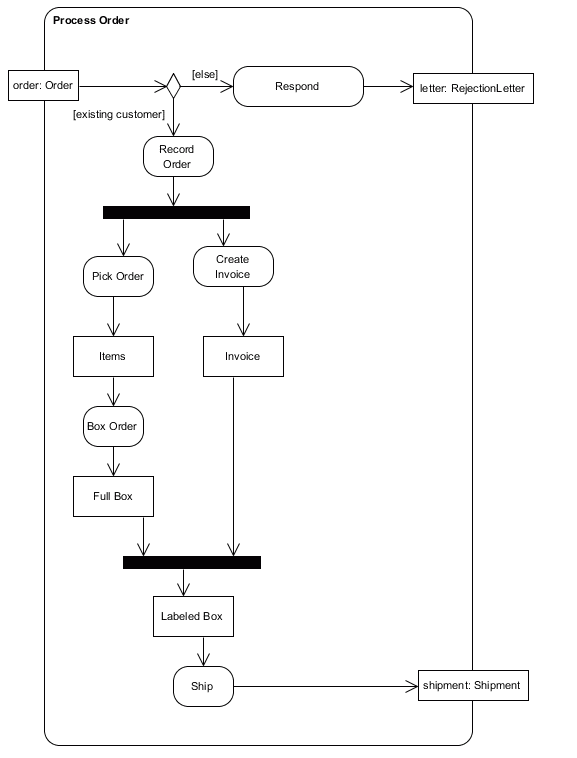| (1) |
_____
|
The system is never an actor in a Use Case Diagram. |
| (2) |
_____
|
A "high resolution" (a.k.a., "low abstraction") Use Case Diagram will tend to have a large number of use cases for the amount of functionality in the system. |
| (3) |
_____
|
A non-functional requirement is a statement that a product must have certain properties. |
| (1) |
_____
|
A system consists of: |
|
||
| (2) |
_____
|
Which of the following is a type of UML diagram: |
|
||
| (3) |
_____
|
Requirements can be recorded using: |
|
||
| (4) |
_____
|
A model is typically: |
|
||
| (5) |
_____
|
A requirement is: |
|
where \(T\) is the time to acquire a target, \(D\) is the distance to the target, and \(S\) is the size of the target. Explain the significance of Fitts's law.
| Design Pattern |
|
|
|
|
| Niche Market |
|
|
|
|
| Software Engineering Design |
|
|
|
|
| Software Product Design |
|
|
|
|
| User Interface |
|
|
|
|
|
|

Collar - A band or chain fastened around the neck of an animal used as a means of restraint or identification.
GPS - The Global Positioning System.
GPS Receiver - A device that receives signals from GPS satellites and uses those signals to determine the devices longitude and latitude.
UDP - The User Datagram Protocol
WES - The Westminster Encryption Standard. A symmetric-key encryption algorithm developed by the Westminster Kennel Club.
The system needs to run for at least 32 hours when the battery is fully-charged. (C2)
Use Case:
PayForProductWithCard
Actors:
User, Bank, Cashier
Trigger:
User inserts Card
Precondition:
The Cashier has taken the product from the User
and entered the price of the product into the System.
Basic Flow:
1. The System reads information off of the Card
2. The System prompts the User to enter the type of Card
(presenting the options "Credit" and "Debit" and "Cancel").
3. The System displays the amount of the payment
(in dollars and cents).
4. The System prompts the User to approve the payment (presenting
the options "Yes" and "No").
5. If the User approves the payment a transaction is sent to the
Bank and the Cashier is notified to give the product to the User.
Extensions:
5a. If the User does not approve the payment, the Cashier
is notified to keep the product and the System is reset.
Identify all of the problems in this use case description and write an improved version.
Playable interface, Note class,
and Chord class:
/**
* The requirements of a Playable in a song
*/
public interface Playable
{
/**
* Play this Playable
*/
public abstract void play();
}
/**
* A single Note in a song
*/
public class Note implements Playable
{
// Details omitted
/**
* Explicit Value Constructor
*
* @param pitch The pitch ('A','B','C','D','E','F', 'G' or 'R')
* @param sharp true for a sharp and false for a natural
* @param octave The octave (relative to middle C)
* @param duration 1 for whole notes, 2 for half notes, etc...
* @param dotted Whether the note is dotted
*/
public Note(char pitch, boolean sharp, int octave,
int duration, boolean dotted)
{
// Details Omitted
}
/**
* Play this Note
*/
public void play()
{
// Details omitted
}
}
/**
* A Chord in a song
*/
public class Chord implements Playable
{
// Details omitted
/**
* Explicit Value Constructor
*
* @param notes The Note objects in the Chord
*/
public Chord(List<Note> notes)
{
// Details Omitted
}
/**
* Play this Note
*/
public void play()
{
// Details omitted
}
}
create a Lyric class that specializes the Note
and adds a void setSyllable(String s) method and a
String getSyllable() method. Remember to include an
appropriate constructor.
JMUmble. In this
system, arriving messages are handled by a PostOffice
object. Depending on how the system is configured at runtime, one or
more objects might need to know when a message arrives. I have
currently implemented several such classes:
ScreenFlasher (which makes the entire screen flash --
you always know when a message has arrived),
PopularityTimer (which starts a clock that show the
amount of time since the most recent message arrived), and
Mumbler (which uses speech generation to read the name
of the person that sent the message -- this is where the system
got its name). Use the Observer Pattern to develop a class model
of this system (in UML). You do not need to include the attributes
of each class, only the operations/methods. Include comments that
describe each operation/method.
|
|
| (1) |
_____
|
Eclipse is: |
|
||
| (2) |
_____
|
Visual Paradigm is: |
|
Copyright 2024